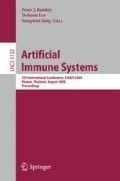Abstract
In this paper, we focus on the potential for applying Kernel Methods into Artificial Immune Systems. This is based on the fact that the commonly employed “affinity functions” can usually be replaced by kernel functions, leading to algorithms operating in the feature space. A discussion of this applicability in negative/positive selection algorithms, the dendritic cell algorithm and immune network algorithms is conducted. As a practical application, we modify the aiNet (Artificial Immune Network) algorithm to use a kernel function, and analyze its compression quality using synthetic datasets. It is concluded that the use of properly adjusted kernel functions can improve the compression quality of the algorithm. Furthermore, we briefly discuss some of the future implications of using kernel functions in immune-inspired algorithms.
Access this chapter
Tax calculation will be finalised at checkout
Purchases are for personal use only
Preview
Unable to display preview. Download preview PDF.
References
de Castro, L.N., Timmis, J.: Artificial Immune Systems: A New Computational Intelligence Approach, 1st edn. Springer, Heidelberg (2002)
Perelson, A.S., Oster, G.F.: Theoretical studies of clonal selection: minimal antibody repertoire size and reliability of self-non-self discrimination. J. Theor. Biol. 81(4), 645–670 (1979)
Freitas, A.A., Timmis, J.: Revisiting the foundations of artificial immune systems for data mining. IEEE Trans. Evol. Comput. 11(4), 521–540 (2007)
Hart, E.: Not all balls are round: An investigation of alternative recognition-region shapes. In: Jacob, C., Pilat, M.L., Bentley, P.J., Timmis, J.I. (eds.) ICARIS 2005. LNCS, vol. 3627, pp. 29–42. Springer, Heidelberg (2005)
Hart, E., Bersini, H., Santos, F.C.: How affinity influences tolerance in an idiotypic network. J. theor. Biol. 249(3), 422–436 (2007)
Stibor, T., Timmis, J., Eckert, C.: On the use of hyperspheres in artificial immune systems as antibody recognition regions. In: Bersini, H., Carneiro, J. (eds.) ICARIS 2006. LNCS, vol. 4163, pp. 215–228. Springer, Heidelberg (2006)
Vapnik, V.N.: Statistical Learning Theory. Wiley-Interscience, Chichester (1998)
Schölkopf, B., Smola, A.J.: Learning with Kernels, 1st edn. MIT Press, Cambridge (2002)
Timmis, J.: Artificial immune systems - today and tomorrow. Nat. Comput. 6, 1–18 (2007)
Timmis, J., Hone, A.N.W., Stibor, T., Clark, E.: Theoretical advances in artificial immune systems. Theoretical Computer Science. Theoretical Computer Science (in press) (2008), doi:10.1016/j.tcs.2008.02.011
de Castro, L.N., Von Zuben, F.J.: aiNet: An artificial immune network for data analysis. In: Abbass, H.A., Sarker, R.A., Newton, C.S. (eds.) Data Mining: A Heuristic Approach, pp. 231–259. Idea Group Publishing (2001)
Esponda, F., Forrest, S., Helman, P.: A formal framework for positive and negative detection schemes. IEEE Trans. Syst. Man, Cybern. B 34(1), 357–373 (2004)
Greensmith, J., Aickelin, U., Tedesco, G.: Information fusion for anomaly detection with the dendritic cell algorithm. Information Fusion(in press) (2008)
Timmis, J., Neal, M., Hunt, J.: An artificial immune system for data analysis. BioSystems 55, 143–150 (2000)
Stibor, T., Timmis, J.: An investigation on the compression quality of aiNet. In: Proc. IEEE FOCI-2007, pp. 495–502 (2007)
Jerne, N.K.: Towards a network theory of the immune system. Ann. Inst. Pasteur. Imm. 125C, 373–389 (1974)
Lau, K.W., Yin, H., Hubbard, S.: Kernel self-organising maps for classification. Neurocomputing 69, 2033–2040 (2006)
de Castro, L.N.: aiNet implementation (2000) (visited in January/2008), ftp://ftp.dca.fee.unicamp.br/pub/docs/vonzuben/lnunes/demo.zip
Author information
Authors and Affiliations
Editor information
Rights and permissions
Copyright information
© 2008 Springer-Verlag Berlin Heidelberg
About this paper
Cite this paper
Guzella, T.S., Mota-Santos, T.A., Caminhas, W.M. (2008). Artificial Immune Systems and Kernel Methods. In: Bentley, P.J., Lee, D., Jung, S. (eds) Artificial Immune Systems. ICARIS 2008. Lecture Notes in Computer Science, vol 5132. Springer, Berlin, Heidelberg. https://doi.org/10.1007/978-3-540-85072-4_27
Download citation
DOI: https://doi.org/10.1007/978-3-540-85072-4_27
Publisher Name: Springer, Berlin, Heidelberg
Print ISBN: 978-3-540-85071-7
Online ISBN: 978-3-540-85072-4
eBook Packages: Computer ScienceComputer Science (R0)

